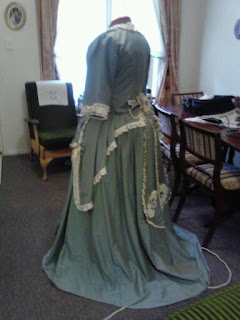I have decided to skip the 1820 work dress for the moment.
I will be doing the stripe challenge and my chosen garment is a Norwegian 'Caraco Dress' this is a very popular style during the later part of the 18th century as working people could wear it.
I have now sewn most of the skirt unfortunately I have to make a bum pad and an underpetticoat before I can attach the Ruffle to get the correct legnth this puts me back so I cannot post it yet.
The bustle is finished and the underpetticoat has only to be hemmed and the ruffle is pinned on so I hope to have it all sewn by this evening after I have pressed it I will post it.
I unable to make the jacket as I have to make a 18th century corset first.
This venture into the 18th century has given me the desire to make another one perhaps with small panniers, but not until I have finished my 1820's peasant dress.
I used a number of pictures the main one which gave me some idea of the shape and the petticoats was
Late 18th Century Skirt Supports: Bums, Rumps, & Culs. By Kendra Van Cleav
I could not find an original 18th century bustle I just had to make one up which would give me the desired shape. I was not keen on the ones giving as examples on the abopve site the last one I felt was too much like a Victorian bustle
The under petticoat I made is very similar to the skirt itself the only difference is the pleats back and front are the same. I just had to guess at this as I could not find an original to copy. .
As you can see my bustle gave me the shape I wanted nice and rounded with just a little bit on the sides.
The front of the skirt which has flat pleating with a box pleat in the centre
The front of the skirt which has flat pleating with a box pleat in the centre
The skirt was three lengths at 112cm and the ruffle five widths of the 112cm by 40cm.
I was a bit short on materials so I had to make the pleats a bit larger than I would have done narmally but I felt that the as original was probably silk and mine would be a cotton of sorts it would do for my first venture into the 18th Century.
I was a bit short on materials so I had to make the pleats a bit larger than I would have done narmally but I felt that the as original was probably silk and mine would be a cotton of sorts it would do for my first venture into the 18th Century.
Close up of the front pleating
Fabric: Cotton/synthetic
Pattern: none
Year: 1780-90
Notions: Cotton Tape
How historically accurate is it? Copy of an original but machine sewn
Hours to complete: 15
First worn: only when being fitted
Total co; Unknown material from my stash



























